
|
Sale 72
February 2-5. 2013
| Lot |
Photo |
Description |
Realized |
Lot 1665 |
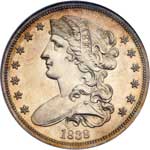 |
1838 Pattern Half Dollar. Silver, Reeded Edge. Judd-72. Pollock-75 Rarity 2. NGC graded Proof 64. CAC Approved. A hint of tone around the edges otherwise white. The William Kneass design completed by Christian Gobrecht after Kneass's stroke. Sharp in the usual areas but also showing diminished design detail in the center (a design challenge that failed to be overcome in this unadopted design). Very choice surfaces with natural light color obtained over decades of careful storage, no doubt in some long-ago collector's coin cabinet. Pop 4; 6 finer, 5 in 65, 1 in 66 (PCGS # 11282) .
Estimated Value $5,000 - 6,000.
View details and enlarged photos
Check results on similar lots
| Realized
$6,325 |
Lot 1666 |
 |
1862 Pattern Half Dollar. Copper, Reeded Edge. Judd-296. Pollock-354 High Rarity 6. NGC graded Proof 64 Brown. Type with GOD OUR TRUST in field above the eagle. One of the sections of the new law authorizing the switch to bronze in the Indian cent in 1864 permitted the Treasury to order the addition of the motto "In God We Trust" to any coin it thought proper. The beginning of the Civil War in 1861 had prompted a great rise in religious fervor, an earlier suggestion in 1861-63 of adding the motto had found a receptive home in the Lincoln administration, especially with Secretary Chase. Several pattern silver and gold coins had been struck during the war to illustrate the concept. Some have the predecessor motto GOD OUR TRUST, while others used the more rhythmic IN GOD WE TRUST. Pop 3; 3 finer (PCGS # 60446) .
Estimated Value $2,500 - 2,600.
View details and enlarged photos
Check results on similar lots
| Unsold |
Lot 1667 |
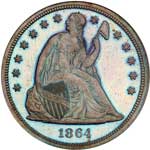 |
1864 Pattern Dollar. Copper, Reeded Edge. Judd-397. Pollock-465 Low Rarity 7. NGC graded Proof 65 Brown Cameo. Lovely blue and brown toning. Great looking coin. A pleasing coin to behold, and almost certainly among the very best preserved Gem Proofs of the variety. Sleek brown color with intense blue, almost turquoise tinted patina on either side; surfaces untrammeled by significant spotting and looking much like it must have when it was prized by some careful collector of the 1870s. The mirrors are nice and reflective, the devices frosted against the mirror field, and the visual appeal is quite pleasing. This is an exceptional Proof 65 specimen! About a dozen examples are known, mainly in slightly lower grades. A highlight for any Pattern collection. Pop 1; none finer at NGC in Brown Cameo .
Estimated Value $7,000 - 8,000.
View details and enlarged photos
| Realized
$12,075 |
Lot 1668 |
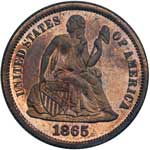 |
1865 Pattern Dime. Copper, Reeded Edge. Judd-421. Pollock-493 High Rarity 7. PCGS graded Proof 64 Red & Brown. A lovely example, bold and gleaming. One of the interesting (and always very rare) regular dies trial strikes, this one in copper using the Proof dies used to strike the silver coins. With so few made, and the havoc played by time and the elements, it stands to reasion this would be one of the top specimens known. Indeed, it is the Finest Graded: Pop 1; none finer at PCGS (PCGS # 70604) .
Estimated Value $7,000 - 7,500.
View details and enlarged photos
Check results on similar lots
| Unsold |
Lot 1669 |
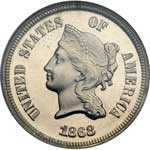 |
1868 Pattern Five Cents. Nickel, Plain Edge. Judd-633. Pollock-704 Rarity 4. NGC graded Proof 66 Cameo. A nice untoned pattern whose gleaming originality is there for all to admire. Well struck. The Mint created a fairly large number of interesting Patterns for the lesser denominations in 1867-71. This carries a head of Liberty by Longacre (who died the year after it was made) similar to his Nickel Three-cent pieces except there is a star on the headband below LIBERTY. Reverse with fancy scoll and an Iron Cross inscribed IN GOD WE TRUST. This Pattern never made it out of the proposal stage, leaving the country with the more familiar Shield Nickel series until 1883.
Estimated Value $3,200 - 3,400.
View details and enlarged photos
| Realized
$3,680 |
Lot 1670 |
 |
1870 Pattern Dime. Silver, Plain Edge. Judd-844. Pollock-943 Low Rarity 6. PCGS graded Proof 63. A nice white coin, boldly struck and gleaming. Part of the Standard Silver series of Pattern coins. The theory behind this petite STANDARD SILVER type was to introduce subsidiary coins into circulation. In effect, it was hoped underweight money could be used to replace the hodgepodge of Fractional Currency then clogging the streams of trade. Why reduce the weight? The belief was this would discourage hoarding and exportation as was occurring with America's regular issues then being struck. This theory never made it into practice; by 1878, gold had returned to par against paper money and small change once again streamed into the country as the squeeze abated and worldwide silver prices began a long decline.Pop 7; 8 finer, 4 in 64, 4 in 65 (PCGS # 61088) .
Estimated Value $1,000 - 1,100.
View details and enlarged photos
Check results on similar lots
| Realized
$1,121 |
Lot 1671 |
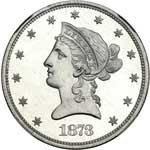 |
1873 Pattern Eagle. Aluminum, Reeded Edge. Judd-1343. Pollock-1487 Rarity 8. NGC graded Proof 66 Star Ultra Cameo. The finest known example. From regular dies, but struck in aluminum with a reeded edge. Other 1873 denominations in Proof aluminum format, which implies that a few sets were formed, perhaps for presentation purposes or sale to well-placed collectors, or more likely, for the private collections of Linderman or other high-ranking mint officials. This meticulously struck Closed 3 Proof 66 Ultra Cameo piece is refreshingly smooth and can be identified easily as the Finest Known.
In this year Dr. Henry R. Linderman was appointed Director of the Mint and Assay offices of the United States by President Grant. He had largely been responsible for writing and securing the passage of the Coinage Act of 1873, which abolished the old silver dollar, half dime and trime [three-cent silver] and authorized the trade dollar. Dr. Linderman had projected the "trade dollar" as a means of finding a market in the oriental countries for our great surplus of silver.
Hence, it is not surprising that a large number of trade dollar Patterns appeared at this time, including sets with the different designs made available to collectors.
As in prior years, Regular Dies Trial Strikes as they used to be known, in copper and aluminum were made from regular Proof dies and often in complete sets for sale to interested parties, with this lovely 1873 $10 Liberty Eagle in aluminum being a prime rarity and top grade specimen combined! Pop 1; none finer at NGC .
Though Pattern coins struck on aluminum planchets date back well before this Liberty Eagle issue, alluminum was still considered a "wonder metal" of the mid- to late-1800s when this 1873 was made. Light and easy to work, it had splendid properties and possibilities. There was only one drawback: price. Although the price of aluminum fell to below that of silver by the early 1860s, it was still expensive to produce, hovering around twelve dollars a pound between 1862 and 1886. It retained this status until metallurgists found a way to smelt it in quantity. As a consequence, the US. mint struck only limited numbers of aluminum Patterns and die trial pieces each year, often Rarity-6 or Rarity-7 items. (In 1889, man's technology finally caught up with his need for large quantities of this miracle light metal; prices plummeted and aluminum was soon being used to make tokens, medals, promotional badges, inflation coins by the jillion, and all sorts of other flimsy doodads.
Estimated Value $17,000 - 18,000.
View details and enlarged photos
| Realized
$28,750 |
Lot 1672 |
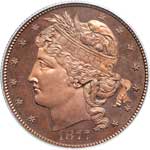 |
1877 Pattern Half Dollar. Copper, Reeded Edge. Judd-1525. Pollock-1691 Low Rarity 7. PCGS graded Proof 65 Red & Brown. CAC Approved PQ. A very popular Pattern Half Dollar. This rarity displays William Barber's distinctive "Metric Head" motif. A lovely Proof with light coppery orange surfaces, slightly faded from full mint red. Sharply struck with moderate cameo contrast. As is the case with a number of other 1877 Pattern Half Dollars, the true rarity is not known. Saul Teichman, a noted authority on Patterns, lists eight different examples of which he is aware, but notes that there are certain other listings which may present further possibilities. Thus, the present variety could be Rarity-7 (four to 12 known), or perhaps high Rarity-6. The splendid surfaces of the present piece rank it high on any listing of examples, indeed it is the finest certified by PCGS. Pop 1; none finer at PCGS (PCGS # 71865) .
Note: More Patterns were made in 1877 than in any other year but almost all were struck in truly minuscule numbers. Most interesting are the rare Pattern half dollars which form a beautiful and interesting series in and of themselves. They include designs by Anthony C. Paquet, William Barber and George T. Morgan.
Estimated Value $25,000 - 28,000.
Ex: Bass-Simpson. Earlier from Bowers & Ruddy�s Armand Champa Collection, May 20, 1972, Lot 1072; prior to that from Stack's Gaston DiBello Sale, May 1970.
View details and enlarged photos
Check results on similar lots
| Realized
$25,300 |
Lot 1673 |
 |
1878 Pattern Dollar. Copper Reeded Edge. Judd-1555. Pollock-1734 Low Rarity 7. PCGS graded Proof 66 Red. Lovely red colors. No visible carbon spots. A wonderful Pattern Dollar. This delightful Pattern bears a head of Liberty facing left. She wears a coronet inscribed LIBERTY. The motto IN GOD WE TRUST is above, the date below. Stars are aligned 7 + 6 on the obverse. The reverse has an eagle with wings spread, holding an olive branch and three arrows. The statutory legend is above and the denomination is below, with E PLURIBUS UNUM in the field above the eagle. Struck in copper with a reeded edge. The Pollock subvariety with the B in PLURIBUS beneath the left edge of the E in STATES. Technically the color designation is adequate "Red", but the most visually appealing aspect of this magnificent pattern dollar is its lovely variation and the way the reflective field propels light from that area of the coin back to the viewer while the more frosted devices give additional contrast and clarity. A miraculous coin, to say the least, given its age and the obvious careful handling it has received in the intervening years to the present! Pop 1; none finer at PCGS (PCGS # 81916) .
Estimated Value $10,000 - 11,000.
View details and enlarged photos
Check results on similar lots
| Realized
$19,550 |
Lot 1674 |
 |
1879 Pattern Metric Dollar. Silver, Reeded Edge. Judd-1617. Pollock-1813 Rarity 4 PCGS graded Genuine. Proof. Untoned and cleaned. Several attempts were made to regularize U.S. denominations with the metric system used in Europe in the 19th century. The 5-gram Shield Nickels of 1866-83 were the first such project. Pattern issues for others were proposed but nothing came of the issue (PCGS # 61995) .
Estimated Value $1,300 - 1,400.
View details and enlarged photos
Check results on similar lots
| Realized
$1,955 |
Lot 1675 |
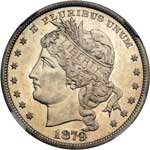 |
1879 Pattern Goloid Metric Dollar. Goloid, Reeded Edge. Judd-1626. Pollock-1822 Rarity 4. NGC graded Proof 63. Mostly untoned. A short-lived experiment seen only in these few Pattern coins. Congressmen being congressmen, they are prone to formulating every sort of harebrained plan for bettering mankind's condition. Hubbell's "goloid" metal and metric weights and measures scheme was just such a one, and it was a humdinger. Goloid metal contained a teensy-tiny amount of pure gold; too little to affect the color of the coin which looks suspiciously like plain, ordinary silver. After the Mint struck an assortment of goloid and metric Patterns, the whole idea was dropped. These few scarce pieces are all we have left to remind us of Mr. Hubbell's divine inspiration.
Estimated Value $2,700 - 2,800.
View details and enlarged photos
| Realized
$2,990 |
Lot 1676 |
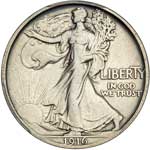 |
1916 Pattern Half Dollar. Silver, Reeded Edge. Judd-1797/1992. Pollock-2053 Low Rarity 7. PCGS graded Proof 50. Untoned and a very important pattern. The designers of the Patterns appearing during this year were apparently influenced by the wars in Europe and this nation's desire for peace.
A. A. Weinman designed a dime in which the obverse was a winged head of Liberty derived from the denarii of Ancient Rome. Hermon A. MacNeil made the designs for a quarter dollar which was "intended to typify in a measure the awakening interest of the country to its own protection." Liberty is shown "stepping forward to the gateway of the country." This half dollar of A. A. Weinman depicts Liberty "progressing in full stride towards the dawn of a new day, carrying branches of laurel and oak, symbolical of civil and military glory. The hand of the figure is outstretched in bestowal of the spirit of liberty." The eagle is "fearless in spirit and conscious of his power" and "his size and proportions are in keeping with the greatness and power of the country." The sapling of mountain pine springing from the rift in the rock is "symbolical of America."'
In recent years some have expressed surprise that when a new specimen of a 1916 Pattern is discovered it is usually worn, quite contrary to what one expects of a Pattern. The fact is that these Patterns so closely resembled the regular issue that they were put into circulation by one owner after another. It seems obvious that there are probably six or more different varieties with about a dozen specimens known over-all.
A significant 20th century Pattern rarity with LIBERTY (appearing as LiberTy) and IN GOD WE TRUST in large letters in the right obverse field. The reverse features an eagle that is a likeness of the final version of the Walking Liberty design, but with there the similarity ends. Above the eagle are the legend UNITED STATES OF AMERICA and HALF DOLLAR, while E PLURIBUS UNUM appears beneath the branch on which the eagle is perched. There are several different variations of 1916 Walking Liberty Half Dollar Patterns known. The earlier issues and the eighth edition of the Judd reference listed six varieties, while Andrew Pollock included a seventh variety. Based on the pedigree research of Saul Teichman on his usPatterns.com website, only about 20 examples of all different varieties are currently known. Five of these are in the Smithsonian Institution, leaving a net available population of just 15 coins according to modern opinion. Pop 1; 3 finer, 2 in 55, 1 in 63 (PCGS # 62290) .
Estimated Value $40,000 - 50,000.
View details and enlarged photos
Check results on similar lots
| Realized
$29,900 |
|
|